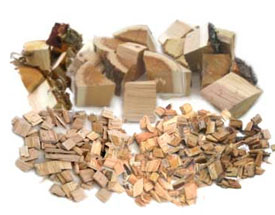It's best to think of the different types of barbecue woods as a seasoning. Each type of barbecue wood has its own distinctive, sultry scent. Originally wood logs were only used as fuel to cook meats, but nowadays most barbecue cookers use charcoal, gas or electricity. The traditional smoke flavor is brought in by wood chunks, wood chips, wood pellets or even wood planks may be used to add a subtle wood smoke flavor with plank grilling.

As wood smoke penetrates the meat it will begin to impart some of its flavor as well. This is why we still continue to cook with hardwoods – wood smoke adds great flavor. Each type of grill will use barbecue woods somewhat differently.
For gas grills you’ll want to use something like a smoker pouch or smoker box for burning wood. If you have a charcoal grill there’s no need - simply mix in your wood in with the coals and it will burn with your charcoal. For pellet smokers you can mix and match flavors of pellets and it will actually use the pellets throughout the entire cook.
Now, you may think that since wood smoke adds a great flavor that more must be better – not necessarily so. You can actually “oversmoke” meat and essentially ruin a dish. This is a common beginner mistake. So start with smaller amounts and as you get the hang of using your grill/smoker to make barbecue, you can gradually add more each time you cook. Wait – you just said pellet smokers use smoke throughout the cook. This is true. However, they do not produce overly smoky food. It’s somewhat counter-intuitive – as the grills get hotter they produce less and less smoke.
Wood Flavors
Which woods are good for barbecuing? Generally, fruit and nut trees make great wood for smoking foods. Specifically, we cook with hardwoods that have low sap/resin content make the best smoke. No conifers such as pine, spruce, fir, cyprus, redwood or cedar. They all contain too much sap which produces a bad flavor when smoked. You also shouldn’t use green wood that hasn’t been cured (dried) or wood that is moldy or lumber scraps (paint, treated, etc).
As a rule of thumb, mild-flavored woods like alder and fruit woods are best for foods with light on season and sauce. Whereas strongly-flavored woods like hickory, mequite, oak, pecan and walnut are more suited for foods with a lot of spices/sauce. For a more in-depth look at the different wood flavors and picking/combining the right woods for the right flavor go see the guide for wood smoke flavors (coming soon).
Different types of wood
There are different types or sizes of wood to use depending on what type of grill/smoker you may be using. For longer cooks and bigger smokers you’ll want to use wood chunks which are normally the size of a fist. Wood chips are smaller (and easy to find) and are best for short cooks or to be added a few times during the cook. Pellets are made from compressed sawdust and must be food-grade. Pellets can be used in place of wood chips or some smokers are specifically designed to run off pellets for both heat and flavor/smoke – they are very controllable and don’t produce over-smoked foods. Some specialty smokers are designed to run off briquettes (often called hockey pucks) or smoldering sawdust.
FAQs for BBQ Woods
How much wood should I use? Remember to think of smoke as a seasoning. Be careful to not add too much. Start out with a few handfuls and add some more when it’s used up and you no longer see smoke. Keep track or measure of how much you use so you can fine-tune it to what you like.
When should wood be added? Meat will absorb most of the smoke before it reaches 120°F. So add some at the start of the cook. Then add more as it gets used up.
Do you need to soak the wood in water? On a gas grill you want to wood to smolder and not catch fire (see smoker box and smoker pouch. So wood chips should generally be soaked, but otherwise for a charcoal grill adding wet wood to your coals will tend to dampen or put out your coals.
How do you cure wood? (Coming soon)
Bark or no bark? It’s a personal preference and I believe it depends on the wood. Some bark seems to produce a skunky, more acrid-type smoke.